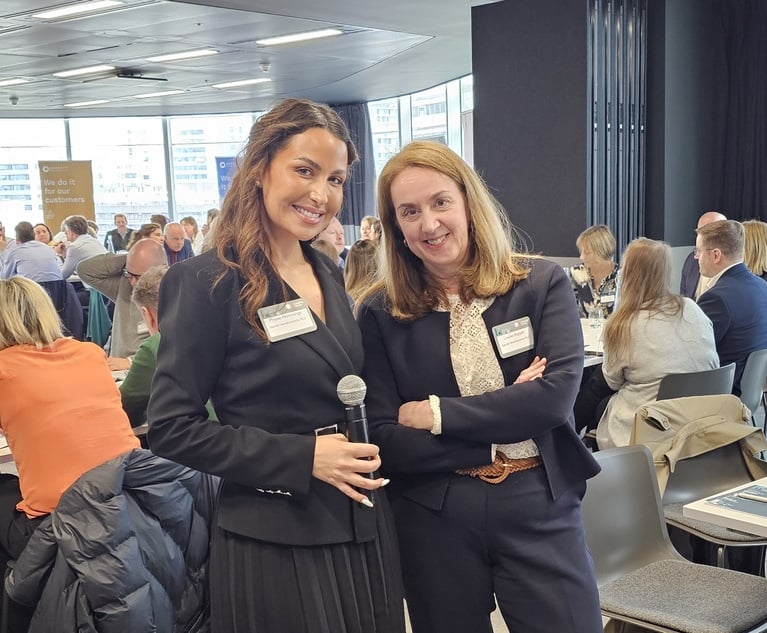In the pink - the FT's GC on networking, peer review and social media
Last summer, Financial Times (FT) general counsel Tim Bratton hired a meeting room for four days in a building around the corner from the daily business newspaper's Southwark headquarters. "I wanted the legal team to take a few days out of the office together in order to have an inward look at the way we function," he says. During those few days Bratton and the six lawyers who report to him "questioned every step of the in-house legal process".
January 19, 2011 at 07:22 PM
6 minute read
Alex Aldridge talks to Financial Times general counsel Tim Bratton about networking, the value of peer feedback and the role of social media for the modern legal chief
Last summer, Financial Times (FT) general counsel Tim Bratton hired a meeting room for two days in a building around the corner from the daily business newspaper's Southwark headquarters. "I wanted the legal team to take a few days out of the office together in order to have an inward look at the way we function," he says. During those few days Bratton and the six lawyers who report to him "questioned every step of the in-house legal process".
The result was a number of changes, including the drafting of a formal statement of the legal team's objectives which their service can be measured against, the introduction of questionnaires for internal clients to fill out upon completion of a job and the creation of an internal legal blog to share information. "It was some of the most valuable time I spent at work last year," says Bratton, 38, of those four days, which also saw the general counsel of a leading bank come in to share his experiences with the team.
Sharing ideas is important to Bratton: "How do you know if what you're doing is right or wrong without comparing it with what your peers are doing?" he asks. But exchanging information is not always straightforward for in-house lawyers. "In a law firm you can walk down the corridor and ask a colleague for advice; but in-house, where you're generally working in a much smaller team, that's not always possible," adds Bratton.
One of the ways he gets round this is through social media, with the FT legal chief a frequent user of micro-blogging site Twitter – tweeting under the moniker @legalbrat and boasting more than 400 followers at the last count. "I get a lot out of it," he says. "It's a great way to share ideas with other lawyers, get legal updates and just network in general."
Bratton has recently launched a blog on which he has reflected on a number of issues, including what chief executives think of lawyers, why US lawyers want to escape private practice and the failure of large law firms to use social media.
However, while Bratton encourages his team to engage with tools like Twitter, he has a few words of warning: "There's a tongue-in-cheek, ironic tone to Twitter, but what you write on there has the capacity to come back and bite you and the company you work for. Really, you've got to treat tweeting like writing a business email, and make sure you don't tweet anything you would not be happy to later admit you tweeted."
Although Bratton sees his role at the FT as "essentially pretty similar to many other in-house legal jobs", there are, he points out, some unique challenges involved in working for the organisation. Many of these relate to the FT's goal of increasing revenue from its digital business. This means fluency in copyright law is a prerequisite for the FT's in-house lawyers, alongside an ability to think commercially about an area that to date has proven notoriously difficult to make money from.
Bratton comments: "We pursue a strategy of selling usage rights accessible to clients who purchase a licence via a range of platforms, including the newspaper's website FT.com, iPad or BlackBerry apps and platforms established by third parties which are licensed to provide FT content, such as LexisNexis. This obviously throws up a range of legal issues which have significant commercial implications.
Handling these involves the team working closely with the sales division and the company's financial decision-makers, with Bratton himself reporting to FT chief financial officer Scott Henderson. The exception is media lawyer Julia Apostle, formerly of DLA Piper, who deals with editorial-related legal concerns and sits permanently on the FT's news desk.
Another key aim of the FT is to expand in the US. This has seen Bratton recently spend three days in New York interviewing candidates for the position of the company's first-ever in-house US attorney. The hire corresponds with the FT's strategy of doing as much of its own legal work as possible in-house – an approach reflected by the team almost doubling in size since Bratton took the general counsel role seven years ago.
As a result, the publication does not doesn't operate a formal panel, although Bratton does have a group of external law firms which he uses regularly: Berwin Leighton Paisner for commercial matters, Reynolds Porter Chamberlain for media work, Freshfields Bruckhaus Deringer for corporate, Winston & Strawn for copyright and DLA Piper for ad hoc pieces of advice across a range of areas. He is keen, however, to impress his willingness to instruct firms outside this group if they are particularly suited to a matter. "Essentially, dealing with external counsel is all about relationships," he comments.
Bratton describes himself as "in a perfect place career-wise right now", but says he could see himself in a purely business role one day, particularly in a publishing or licensing environment. "But who knows what might be next," continues Legal Week's 2005 Most Promising Young In-House Lawyer. "I don't worry about that too much."
Career timeline
1994 – Graduates from Durham University in law
1996 – Begins training contract with Denton Hall
2000 – joins FT.com as legal adviser
2002 – FT.com is merged with Financial Times (FT) newspaper
2002 – promoted to legal manager for FT
2003 – Goes on three-month (non-legal) secondment for FT.com's business development team
2003 – Promoted to FT general counsel
Tim blogs at thelegalbratblawg and you can click here to follow Tim on Twitter.
- Click here to follow Legal Week on Twitter.
This content has been archived. It is available through our partners, LexisNexis® and Bloomberg Law.
To view this content, please continue to their sites.
Not a Lexis Subscriber?
Subscribe Now
Not a Bloomberg Law Subscriber?
Subscribe Now
NOT FOR REPRINT
© 2025 ALM Global, LLC, All Rights Reserved. Request academic re-use from www.copyright.com. All other uses, submit a request to [email protected]. For more information visit Asset & Logo Licensing.
You Might Like
View All
Broadcom Hires From Nuclear Giant to Appoint French Legal Head

GCs Say They are Getting 'Edged Out' of UK Boardrooms

'I Won’t Name the Firm, But...'—Barratt Redrow's Legal Head on External Counsel Red Flags
Trending Stories
- 1Bracewell Adds Former Pioneer Natural Resources Lawyer to O&G, Energy Transition Practices
- 2Send Us Your New Partners for The Legal's 2025 New Partners Yearbook
- 3Another US Firm Shutters London Office
- 4The Future of Data Protection Enforcement: It’s Hammer Time!
- 5Deep-Seated Legal Department Woes—From Data in Disarray to Communication Dysfunction—Threaten to Temper Gen AI's Transformative Powers
Who Got The Work
Michael G. Bongiorno, Andrew Scott Dulberg and Elizabeth E. Driscoll from Wilmer Cutler Pickering Hale and Dorr have stepped in to represent Symbotic Inc., an A.I.-enabled technology platform that focuses on increasing supply chain efficiency, and other defendants in a pending shareholder derivative lawsuit. The case, filed Oct. 2 in Massachusetts District Court by the Brown Law Firm on behalf of Stephen Austen, accuses certain officers and directors of misleading investors in regard to Symbotic's potential for margin growth by failing to disclose that the company was not equipped to timely deploy its systems or manage expenses through project delays. The case, assigned to U.S. District Judge Nathaniel M. Gorton, is 1:24-cv-12522, Austen v. Cohen et al.
Who Got The Work
Edmund Polubinski and Marie Killmond of Davis Polk & Wardwell have entered appearances for data platform software development company MongoDB and other defendants in a pending shareholder derivative lawsuit. The action, filed Oct. 7 in New York Southern District Court by the Brown Law Firm, accuses the company's directors and/or officers of falsely expressing confidence in the company’s restructuring of its sales incentive plan and downplaying the severity of decreases in its upfront commitments. The case is 1:24-cv-07594, Roy v. Ittycheria et al.
Who Got The Work
Amy O. Bruchs and Kurt F. Ellison of Michael Best & Friedrich have entered appearances for Epic Systems Corp. in a pending employment discrimination lawsuit. The suit was filed Sept. 7 in Wisconsin Western District Court by Levine Eisberner LLC and Siri & Glimstad on behalf of a project manager who claims that he was wrongfully terminated after applying for a religious exemption to the defendant's COVID-19 vaccine mandate. The case, assigned to U.S. Magistrate Judge Anita Marie Boor, is 3:24-cv-00630, Secker, Nathan v. Epic Systems Corporation.
Who Got The Work
David X. Sullivan, Thomas J. Finn and Gregory A. Hall from McCarter & English have entered appearances for Sunrun Installation Services in a pending civil rights lawsuit. The complaint was filed Sept. 4 in Connecticut District Court by attorney Robert M. Berke on behalf of former employee George Edward Steins, who was arrested and charged with employing an unregistered home improvement salesperson. The complaint alleges that had Sunrun informed the Connecticut Department of Consumer Protection that the plaintiff's employment had ended in 2017 and that he no longer held Sunrun's home improvement contractor license, he would not have been hit with charges, which were dismissed in May 2024. The case, assigned to U.S. District Judge Jeffrey A. Meyer, is 3:24-cv-01423, Steins v. Sunrun, Inc. et al.
Who Got The Work
Greenberg Traurig shareholder Joshua L. Raskin has entered an appearance for boohoo.com UK Ltd. in a pending patent infringement lawsuit. The suit, filed Sept. 3 in Texas Eastern District Court by Rozier Hardt McDonough on behalf of Alto Dynamics, asserts five patents related to an online shopping platform. The case, assigned to U.S. District Judge Rodney Gilstrap, is 2:24-cv-00719, Alto Dynamics, LLC v. boohoo.com UK Limited.
Featured Firms
Law Offices of Gary Martin Hays & Associates, P.C.
(470) 294-1674
Law Offices of Mark E. Salomone
(857) 444-6468
Smith & Hassler
(713) 739-1250







